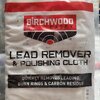AJC1
Member
I'd try 6.6 6.8 and 7.0 if that's above minimum as that 7.0 load looks promising.Well I tested the .357 loads today along with a load workup for 44 magnum using rimrock 158gr and 240gr lswc's. The results are as follows.
.357, starline cases, 158gr lswc, rem 5 1/2 primer, be86 powder, coal 1.572.
7.0gr: SD 6.6, avg vel. 1130, es 21.
7.2gr: SD 13.8, avg vel. 1148, es 43.
7.4gr: SD 16.3, avg vel. 1190, es 55.
There was leading in the barrel and a little bit in the cylinder throats. Leading cleaned up pretty easy but I'm going reduce my load under the 7.0gr to get my velocities around 1000-1050. I think 6.5gr should do it. Accuracy was about as good across the charge weights as I am. Fired cases fell out of the cylinder and were clean. I forgot my pistol rest at home and had to shoot off hand at 25 yds.
.44 magnum, starline cases, 240gr lswc, win wlp primer, be86 powder, coal 1.58.
9.5gr, SD 16, avg vel 1093, es 59.
10gr, SD 11, avg vel 1134, es 37.
10.5gr, SD 13, avg vel 1169, es 47.
Leading was pretty bad and took longer to scrub out of the barrel and cylinder throats than the .357 loads. Mabye my throats are tight in the 44. Accuracy was comparable to the .357. Cases fell out of the cylinder with ease and primers looked excellent. Cases were clean. My crimp needs to be tighter, I has some bullet pull on the last round in the cylinder. I'll most likely reduce this load to 8.5gr to try and achieve 850 to 900fps.
9.8 might be your huckleberry in 44. Don't know.
I have started chasing and dialing in for es/SD because I want to know where the powder is happy as I try and map the powders happy place. It allows me to figure out where to expect simular results with other bullets and loads.


